|
|
|
|
|
|
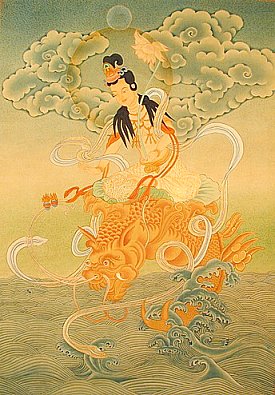
Ryūzu Kannon 龍頭観音 (Dragon-Head Kannon)
atop sea monster. Photo from tibetshop.com.
In Japanese paintings, Ryūzu Kannon (one of the 33 traditional forms of Kannon in Japan) is typically shown atop a dragon (a legendary member of the Vedic group of serpentine creatures known in Sanskrit as the Naga). But in this modern Japanese painting, the dragon appears to be a Shachihoko (an imaginary ocean beast with the head of a tiger and the body of a fish). Moreover, the dragon in this painting looks similar to a carp (Jp. = Koi 鯉) transforming into a dragon, a common artistic theme from old China. This theme is based on a Chinese legend (Jp. = Koi-no-Takinobori 鯉の滝登り) wherein carp swim, against all odds, up a waterfall known as the “Dragon Gate” at the headwaters of China’s Yellow River. The gods are very impressed by the feat, and reward the few successful carp by turning them into powerful dragons. The story symbolizes the virtues of courage, effort, and perseverance, which correspond to the nearly impossible struggle of humans to attain Buddhahood. In modern Japan, temples and shrines commonly stock their garden ponds with carp, which grow to enormous sizes in a variety of colors.
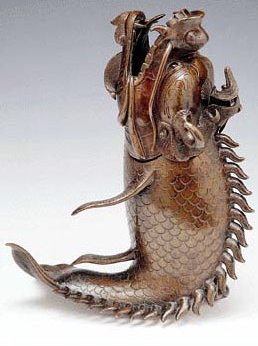
Censer in form of leaping carp
transforming into dragon. Unknown artist.
China, 1st half of 17th century, Ming Dynasty.
Photo courtesy Phoenix Art Museum
|
|
 Shachi 鯱 or Shachihoko 鯱鉾 Shachi 鯱 or Shachihoko 鯱鉾
Literally “Killer Whale”
Imaginary creature with the
head of a tiger and body of a fish.
Used in Japan as roof ornaments
to provide protection against fire.
ORIGIN UNKNOWN
Probably derived from the ancient Vedic sea monster known (in Sanskrit) as Makara. Also possibly derived from a type of Chinese temple-roof ornament known in Japan as Shibi 鴟尾.
DESCRIPTION
Shachi or Shachihoko were frequently used as roof ornaments in the Edo period (1600-1868) and found atop castles, tower gates, and samurai homes. These fish-shaped ornaments are placed at both ends of the main roof ridge, with the male Shachi placed on the left and the female Shachi on the right. The creatures are thought to provide protection against fire, as they are attributed with the power to control rain.
MAKARA
Sanskrit term for sea monster (Jp. = Keigyo 鯨魚), transliterated into Chinese as 摩竭. Often described as having the body of a crocodile and other whimsical parts. In Southeast Asia, Makara frequently adorn temple lintels and arches, and are often depicted with a dragon emerging from their mouths. One of the main characteristics of the Makara in India and Southeast Asia is the elongated nose, like that of an elephant.
MAKATSU
Another Sanskrit term meaning MAKARA, which is depicted in Asian art as a composite sea monster in the shape of a gigantic whale, fish, turtle, crocodile, shark, or dolphin. Japanese depictions of this sea creature differ somewhat from those found throughout Southeast Asia, for Japanese versions lack the elongated nose.
VARUNA (Japanese = Suiten)
Quote from Buddhism: Flammerion Iconographic Guide:“Varuna is god of the ocean and one of the Dikpala (Hindu deities who rule the specific directions of space). Varuna holds a lasso and is often shown riding a Makara. Varuna is the ancient Vedic god of the waters, the "Govenor of the West." According to the Laws of Manu (an important Hindu text), Varuna "ties the guilty with ropes." He is also called Nagapasa, the "Magic Rope of the Naga" (in Japanese known as Ryuuson, the Venerable Dragon; naga are serpentine creatures, including the snake and dragon). The Vajradhatu Mandala (Jp. = Kongōkai 金剛界曼荼羅 or Daimond World Mandala) positions Varuna in the Southwest, assigns him a blue or grey-green color, and has him mounted on a nine-headed dragon. He is represented in Japan, especially in painting, seated on a turtle or dragon in the midst of the waters (Site Editor's Note. I can't find any examples of this). Serpents emerge from his hair. His right hand is closed or holds a sword vertically, and his left hand holds a rope or a serpent. He sometimes stands on a turtle or a dragon, holding a rope in the hand, or seated and holding a lotus supporting a triple jewel. Some consider Varuna to be a healer and a protector against illness.” <end quote>
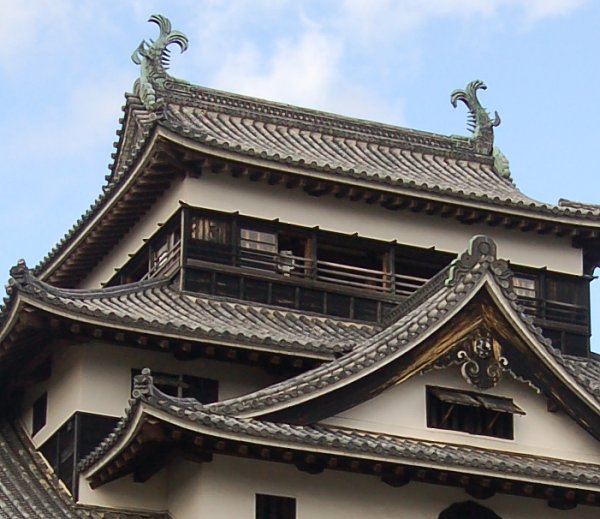
Shachihoko atop Matsue Castel 松江城 (Matsue-jō), Shimane Prefecture.
Made of bronze. Shachi on the left is male, the one on the right is female.
Both approx. 2.08 meters in height.
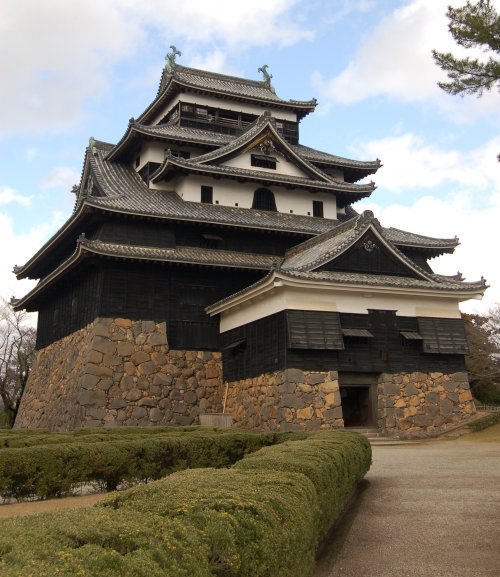
Shachihoko atop Matsue Castel 松江城 (Matsue-jō), Shimane Prefecture
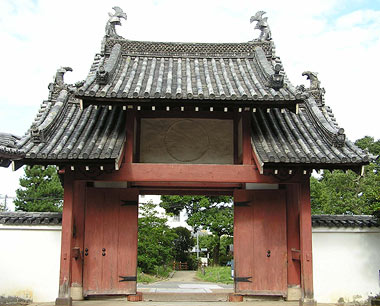
Manpukuji Sōmon 萬福寺総門 (Kyoto). Photo courtesy JAANUS.
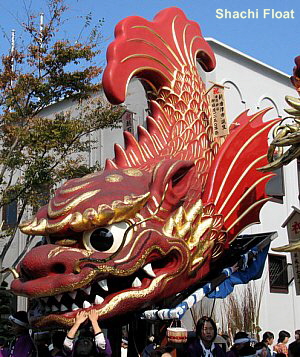 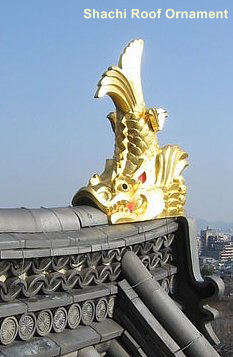
L: Shachi float (constructed 1876), Karatsu Festival in Karatsu City, Saga Prefecture
R: Shachi atop Okayama Castle 岡山城 in Okayama City, Okayama Prefecture
PHOTOS courtesy Wikimedia Commons
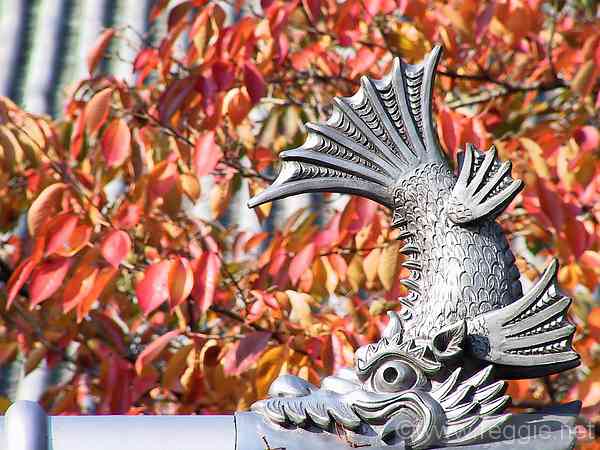
Shachihoko at Tokuyu-ji Temple, Naramachi, Nara. Photo by Reggie Thompson

Shibi 鴟尾 (or 鵄尾 or 蚩尾 or 鮪)
Also called Kutsugata 沓形 (lit. shoes tile) or Tobi-no-o 鴟の尾
Origin unknown, but these tail-shaped roof ornaments were first used in China, and became popular in Japan in the Asuka and Hakuhō periods (552 - 710). They were positioned on the main ridge of temples and palaces, and were thought to provide protection against fire. The fish-shaped Shachi roof ornament probably derived from the Shibi. Japan’s oldest extant Shibi are found at Tōshōdaiji Temple 唐招堤寺 in Nara and are dated to the 8th century. The popularity of this architectural form began to wan by the early 14th century.
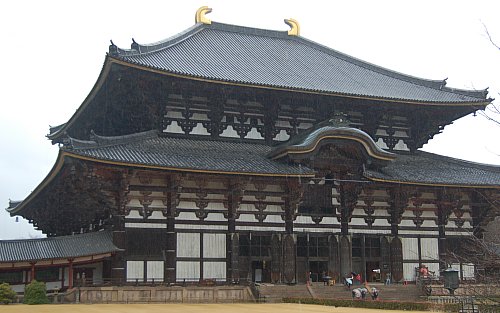
Tōdaiji Kondō 東大寺金堂 (Nara)
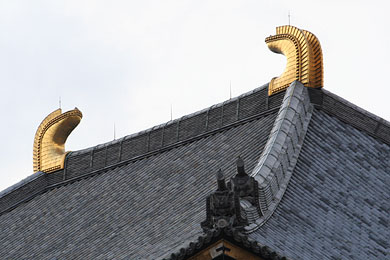
Tōdaiji Kondō 東大寺金堂 (Nara). Photo courtesy JAANUS.

LEARN MORE
- Early Buddhist Architecture in Japan
Japanese Arts Library, Vol. 9, by Kakichi Suzuki (Author), Mary Neighbor Parent (Translator)
- Makara Photos from Art-and-Archaeology.com
- Buddhism: Flammarion Iconographic Guides
by Louis Frederic, Printed in France, ISBN 2-08013-558-9, First published 1995. A highly illustrated volume, with special significance to those studying Japanese Buddhist iconography. Includes many of the myths and legends of mainland Asia as well, but its special strength is in its coverage of the Japanese tradition. Hundreds of accompanying images/photos, both B&W and color. A useful addition to your research bookshelf.
- Japanese Architecture and Art Net Users System
- See Entry on on Shibi
- See Entry on Shachi
- Carp Ascending a Waterfall (Koi-no-Takinobori 鯉の滝登り)
Says JAANUS: The Chinese legend of a carp that became a dragon after swimming up a waterfall at the headwaters of the Yellow River. This auspicious theme, a parable of effort and success, is linked to the Japanese Boys Day Festival (5th day of fifth month) when carp streamers (koinobori 鯉のぼり) are displayed. The theme was depicted in Edo period art, as for example in the painting by Maruyama Oukyo 円山応挙 (1733-95; Daijouji 大乗寺, Hyogo) or prints by ukiyo-e 浮世絵 artists.

|
|